A Look Back at Disney Video Games
The best and worst of classic Digital Disney

If there were two things I loved back when I was growing up, it was Disney animated films and video games. So, naturally, when the two joined together, it was always a happy occasion for my younger self. Best of all, a lot of the Disney games back in the day were put out by reliable companies like Capcom and Sega, meaning that a majority of the games were good to excellent. That's not to say that some bombs didn't sneak in. But, for the most part, things were good.
This article is not going to be a "best of..." list. There will be no ranking of the games in any order. It will simply be my honest opinions on these games, and my final grade on a 1 to 4 rating scale (1 being lowest, 4 being highest ranking). Also, this is not going to be a complete list of Disney games, just the ones that I played back in my youth. So, you will see some titles missing. So, with all that out of the way, let's get on with the games!
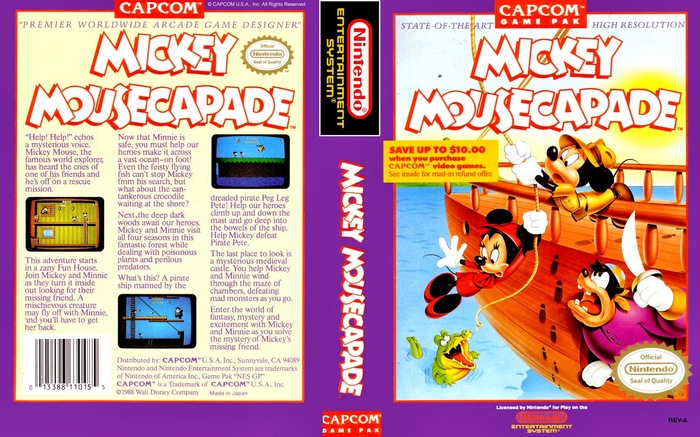
MICKEY MOUSECAPADE (1988)
FORMAT: NES
PUBLISHER: CAPCOM/HUDSON SOFT
The first major Disney video game release of the NES generation did not exactly get things off to a flying start. I remember being especially excited when I saw this game available for rent at my video store the first time. Not only was this a Disney game, but it was published by Capcom, one of my favorite third parties on the NES growing up. In the words of that immortal video game character, Bubsy the Bobcat, "What could possibly go wrong"? However, what few kids knew at the time is that even though Capcom published the game in the U.S., they had nothing to do with the making of it. This game was originally released simply as "Mickey Mouse" for the Japanese Famicom a year earlier in 1987 by Hudson Soft, the company best known for releasing the Adventure Island games at the time. Capcom bought the American rights to the game, and brought it over here. When all is said and done, they would have been better off making their own Mickey game, instead of unleashing this frustrating thing on innocent American children.
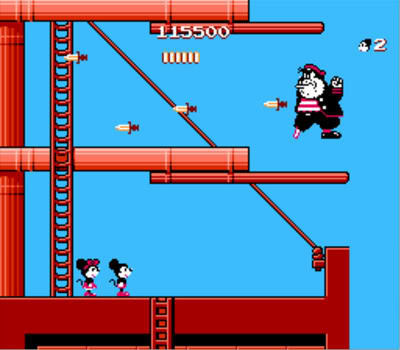
This is a very basic and uninspired platformer where you guide Mickey and Minnie across levels such as a fun house, the ocean, and a pirate ship in order to rescue Alice (from Alice in Wonderland) from an evil witch. Despite there being two playable characters, this is simply a single player game. You control both mice at the same time. They jump at the same time when you hit the button, and they attack (by throwing magical stars at enemies) at the same time. This is kind of a cheap tactic, as if you see two characters in the game on the back of the box, you would automatically assume that you could play this with a friend. But then, you would have to find a friend who would want to play this thing...

This is a highly frustrating game in just about every regard. The enemies are cheap and get off some unfair hits quite a bit, the control on Mickey and Minnie is very loose and floaty, and there are just some really annoying aspects to the game. The most annoying is that certain enemies can capture Minnie and carry her away. This doesn't hurt you, but you can't clear the stage without Minnie, so you then have to backtrack and search through every inch of the level to find where she is being hidden. And once you find her, she can technically be captured again. What fun. What this game basically amounts to is you trying to squeeze fun out of it, while the monotonous music drills its way into your skull, and you begin to question your sanity when you think back on why you decided to play this.
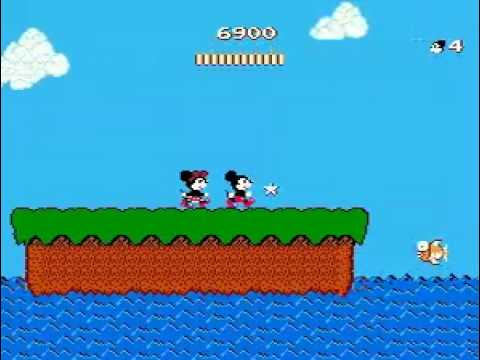
This doesn't even feel like a Disney game, as there are very few characters from the Disney universe to look out for, though a couple like Pete, as well as the Crocodile from Peter Pan, turn up as bosses. This is your standard generic platform game that's had some recognizable characters slapped on in order to lure in kids. The game was a disappointment back in the day, and is even worse if you attempt to go back and play it now.
Final Rating: 1.5 out of 4.

DUCKTALES (1989)
FORMAT: NES
PUBLISHER: CAPCOM
Now this is more like it! Despite not being the best quality, Mickey Mousecapade was able to sucker enough kids to buy it, and become a success for Capcom. This led to the company securing an exclusive agreement to publish Disney-themed games for Nintendo, and the first fruit of this development deal was none other than DuckTales, based on the wildly successful syndicated cartoon that was mesmerizing kids every day after school at the time.

To put it bluntly, this game is everything that Mickey Mousecapade was not. Not only does it do a great service to the license by including just about every major character from the cartoon, but it's just so incredibly fun to play. You naturally play as Scrooge McDuck, that globe-trotting, child-endangering adventurer and Richest Duck in the World. The game's set up is simple. Scrooge wants even more money, so he decides to travel the world to places like the Amazon, Transylvania, African Mines, the Himalayas, and even the Moon in order to find lost treasure. What made this game so fun is Scrooge's unique attack, where he could "pogo jump" off of the heads of enemies with his cane. Not only that, but he could use this special jump to get across beds of spikes, cavernous pits (by leaping off of enemies heads and flying across), and he could even use his cane like a golf club and swing rocks and bricks into the heads of enemies, or to reveal hidden locations and areas in the levels. While this was a fairly simple game overall, there was a lot to explore, as every level had hidden rooms, areas and other secrets for kids to discover. The game even had multiple endings, depending on what your total cash amount was at the end of the game.

DuckTales had it all. Fantastic level design, cameos by most of the major cast of the show who would try to help out Scrooge or give him advice, and controls that made performing Scrooge's various moves and attacks almost second nature from the second you picked up the NES controller. And then there was that outstanding music score. Sure, everyone remembers the music on the Moon level, which most people consider one of the finest video game compositions ever achieved on the NES. This song alone has been remade countless time by various video game music tribute bands, and just going on Youtube can bring up a sheer massive list of renditions of that one song alone. But that doesn't mean the rest of the music isn't great. In fact, every area has wonderful musical accompaniment that perfectly captures the mood of the level - From the bouncy and happy Amazon music, to the more foreboding melodies of Transylvania. The only drawback to the game is that it was extremely short, and could be beaten by just about every kid during a single rental period. However, due to how fun it was the vast amount of secrets in every level, this was the kind of game you could easily revisit over and over.

Capcom brought some of their best team members on board here, and it shows in just about every way. In fact, many of the people who worked on DuckTales also worked on Capcom's flagship Mega Man franchise at the time. This was simply a high quality production that is still remembered fondly to this day. There was a sequel late in the NES' life, and even a remastered remake for modern day consoles a few years ago. But, in my mind, nothing has quite matched the quality of the original great.
Final Rating: 4 out of 4

CHIP 'N DALE'S RESCUE RANGERS (1990)
FORMAT: NES
PUBLISHER: CAPCOM
The DuckTales game came out right around the time the Rescue Rangers cartoon hit TV, so we naturally started dreaming of Capcom doing a follow up based on the newest cartoon. One eventually came in the summer of 1990. Chip 'n Dale's Rescue Rangers is an equally excellent game that, like DuckTales, is still remembered fondly today by gamers who grew up in the late 80s and early 90s.

As is to be expected, the story is simplicity itself. The Chipmunk duo and their team of pint-sized crime fighters set out on a mission to find a little girl's lost kitten. However, when they set out on their quest, they find the local area littered with robotic dogs, lizards, flying squirrels, and other animal oddities. This can only be the work of the Rangers' arch enemy, Fat Cat, who used the lost kitten situation as a ploy to lure the Rescue Rangers out so he could kidnap their friend Gadget the mouse. Now Chip and Dale must rescue their friend, and stop Fat Cat.

You can tell that Capcom learned a lot of lessons from DuckTales and made some big improvements. For one thing, this is a much longer game, though it's still painfully short given how much fun it is. Also, real 2 player support was finally added. You and a friend could play as the titular chipmunk heroes, and you could either work together, or work against each other. Chip and Dale would attack enemies by picking up boxes and throwing them at any threat. But, you could also hit each other. Even though it wouldn't hurt the other player, it would briefly knock them out, displaying stars swirling around their head. Part of the fun of the game was just flinging boxes every which way, trying to hit each other. It sounds silly, but trust me, that's half the fun of the two player mode. Also fun was the ability to pick up and carry the other player, then throw them in order to put them down.
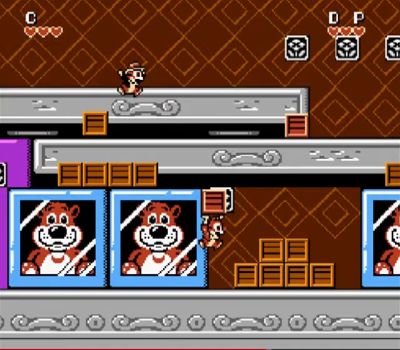
In terms of gameplay, Rescue Rangers had longer levels, but not as much depth as DuckTales did. There weren't really any secrets to discover, no alternate endings, and every level was just a straight path to the boss. This, along with the fact that there are not many characters taken from the show in the game, are the two biggest disappointments when it comes to this game. Still, this is an incredibly fast paced game. Given that Chip and Dale are small and quick, the game makes great use out of this aspect, by having the characters run through everyday places like a police station or a cafe where everyday objects like telephones and stools seem so much larger than you. It really gave the illusion of being a small little guy in a huge world of humans.
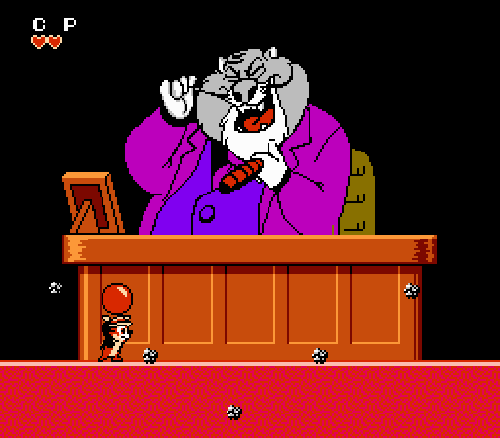
Much like DuckTales, the game was fairly simplistic, and could easily be beaten as a rental. But, once again, the game was so much fun (especially in 2 player mode), nobody really cared. This game isn't quite as remembered as fondly as its predecessor, but it's still a total blast, and just as much fun to come back to today. If you have kids, and you want to show them the kind of games you played when you were their age, this is a great one to pick.
Final Rating: 3.5 out of 4

CASTLE OF ILLUSION: STARRING MICKEY MOUSE (1990)
FORMAT: SEGA GENESIS
PUBLISHER: SEGA
At the same time Capcom was in the early stages of a successful partnership with Disney on Nintendo, Sega was getting ready to kick off their own partnership in a big way on their shiny new 16-bit system. Castle of Illusion was a big deal back in the day, and it was actually used as a showcase game for the Genesis when it first came out in order to show off the big difference between Sega's new console, and the 8-bit Nintendo. Due to the increased graphical power of the Genesis, Mickey Mouse could be just as colorful and expressive in video games as he was in animation. In fact, one of the big reasons this game got so much attention at the time was that Mickey was one of the first video game characters who could react or change facial expressions depending on what was happening to him. Whether he was running, jumping, or teetering on the edge of a cliff, Mickey would react appropriately on the screen.

As for the game itself, it involved Mickey making his way through the titular Castle of Illusion in order to save Minnie, who had been snatched away by an evil witch. After entering the Castle at the start of the game, Mickey would have to make his way through five different rooms in order to reach the tower where Minnie was being kept. Because it was a magic castle, the rooms could be a wide variety of different areas, such as a foreboding forest, a deadly world of toys, a magic library, and even a dangerous candy land, where Mickey would have to jump across cakes and pies over a flowing river of milk. There were a lot of imaginative elements to the levels, and no two were alike. In the toy world level, there were blocks that Mickey could touch that would turn the screen upside down, so that he would be walking on the ceiling for part of the level. In the maze-like library level, he would have to swing upon lamp cords (which would turn the lights off in the room briefly), and explore jars and bottles in order to warp to another part of the level.

This was a wonderful game for Sega to showcase the power of their brand new system, as nothing on Nintendo's aging console could match the color, animation and music that Castle of Illusion displayed. The programmers put a lot of detail and attention to every facet of the game, and it showed. Of course, like all the great Disney games at the time, it was also very short and kind of on the easy side. There were no puzzles or real tricky spots that would test gamers' platforming skills. You really wanted this game to be much longer, because what was here was so imaginative and well done. If the game had been twice as long, it would have been a true masterpiece.
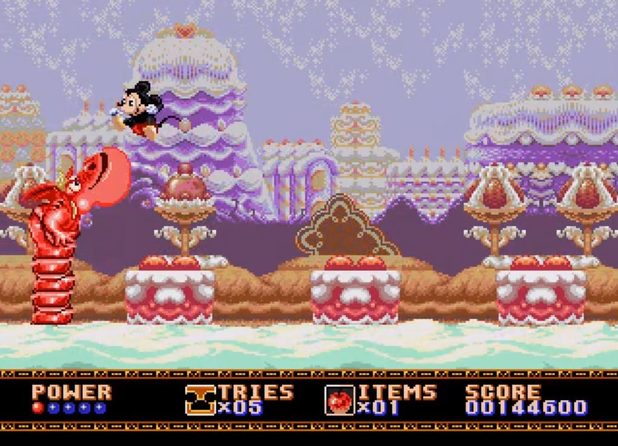
Regardless, this wasn't just a great technical demo that showed what the Genesis could do, it was a truly great game in general. Not only that, it more than made up for Mickey Mousecapade, and gave the Disney mascot a game worthy of his name.
Final Rating: 3.5 out of 4

ADVENTURES IN THE MAGIC KINGDOM (1990)
FORMAT: NES
PUBLISHER: CAPCOM
After two hits in a row based on Disney animated shows, Capcom decided to do something a little different with their next title. Adventures in the Magic Kingdom was a game based on the Disneyland theme park. It combined a variety of different gameplay styles like platforming, overhead racing, and even first person space shooting stages that were based on different actual attractions and rides from the park itself, like the Haunted Mansion and Space Mountain. On paper, this sounds like a brilliant idea, and quite possibly the ultimate Disney game for the fans. But in execution, the end result is highly mediocre and forgettable.

As the game opens, you get a static cinema of Mickey, Donald and Goofy standing around, talking about how there's going to be a big parade in the Magic Kingdom theme park. Unfortunately, the parade can't start, because that big doofus Goofy has lost the keys required to open the gate and start the parade. The three famous toons are too lazy to get off their butts and actually do something about this, so they decide to rely on good old fashioned child labor, and recruit a dumb looking kid wearing an equally dumb looking cowboy hat for unexplained reasons to do their dirty work for them. The kid will have to venture through five different levels in order to get the keys back. As mentioned, the levels range from platform-based (Haunted Mansion and Pirates of the Caribbean), overhead racing (Big Thunder Mountain Railroad and Autopia) and first person space shooter (Space Mountain). Not only that, but you'll also have to walk around the park itself, talking to various tourists and answering Disney-related trivia in order to obtain yet another key. The trivia questions in the game could range from simple to downright diabolical. (Do you know Donald Duck's middle name? Did you know he even had a middle name?)

As for the individual levels, most of them are extremely frustrating. I remember renting this game as a kid, and not really being able to beat any of the levels in it. If a lot of the Disney games can be accused of being too simple and short, then this one could probably be blamed for being too frustrating for its target audience. There are a lot of difficult jumps, and enemy placement that seems designed to hit you when you're off guard. I went back and played this game for the article, and was actually able to finish it this time around. It wasn't quite as hard as I remember it being, but it's still not that good. The level design just isn't as good as DuckTales and Rescue Rangers, and there's not much imagination to the levels themselves. Sure, you can see some cute references to some of the rides (like when you walk by a mirror in the Haunted Mansion, and you see a ghost instead of your reflection), but there's just not a lot of passion behind this one. It feels kind of rushed and cheap.

No, this is not as bad as Mickey Mousecapade, but it's definitely mediocre, and nowhere near as good as it should have been. This is an example of a wonderful idea that just went wrong somewhere in its execution.
Final Rating: 2 out of 4

FANTASIA (1991)
FORMAT: SEGA GENESIS
PUBLISHER: SEGA
Oh boy, now we really get to scrape the bottom of the barrel. Fantasia for the Sega Genesis is easily the worst Disney game ever made. Based on Walt Disney's experimental 1940 film that combined classical music with animation, this one has horrible gameplay, level design and controls. They couldn't even get the music right, and considering that's what the film was built around, you would think they would at least had put some effort into it. This is a game that haunted my childhood, and going back to play it as an adult did not make things much better.
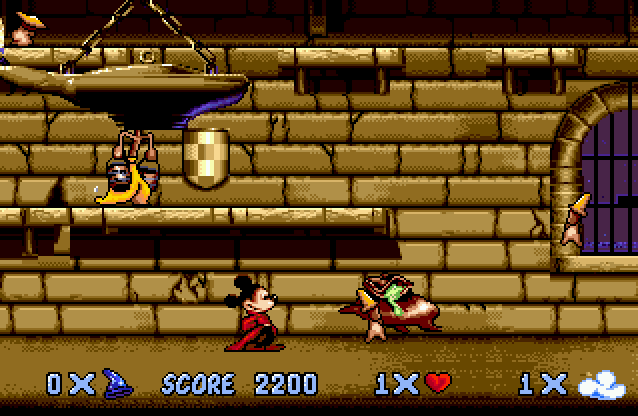
Since the movie had no plot, the developers had to make one up. Mickey Mouse (dressed as the Sorcerer's Apprentice here) is sleeping one day, when an evil wind from nearby Bald Mountain blows in from outside, and ends up stealing all the musical notes by blowing the notes right off the sheet music. Now Mickey must make his way across various levels based on the different animated shorts from the film itself to get the notes back so that the orchestra can play. You start the game out in the Sorcerer's basement, where the famous marching brooms from the movie will menace you. Later levels include forest gardens where hippos dance ballet, prehistoric jungles, and finally the ominous Bald Mountain, where demons and ghouls will menace you while the foreboding demon Chernabog will look on.

Given that the Fantasia movie used a lot of fantasy-related settings that ranged from horror to Greek mythology, this actually could have worked really well for a video game. Just like in Adventures in the Magic Kingdom, the idea is brilliant, but the execution is totally off. First of all, Mickey is a total chore to play as. He has two attacks at his disposal - jumping on enemies or shooting bursts of magic. Unfortunately, neither of these will give you much of an advantage, as the enemies in this game are relentless, and there is a slight delay between the button press and Mickey responding. The levels are massive, sprawling and hold secret areas, but it's hard to enjoy this feature when you're constantly wrestling with the sloppy controls and the obscene difficulty of the game itself.

As I mentioned, the goal of the game is to find all the musical notes in every level. And the notes are hidden...well. Some are out in the open, some are locked away in secret areas that you have to discover on your own (and there's no hint as to where to look), and some are actually invisible until you jump or shoot at the right spot on the screen. And if you reach the end of the level and don't have all the notes, the conductor of the orchestra will force you to go back and play the level all over again. And yes, you have to collect all the notes all over, even the ones you got last time. Talk about tedium. And what is your reward for all this punishment? Quite possibly one of the worst endings I've ever seen in a video game. There's no final boss at all. In fact, the last level just completely stops like the programmers ran out of time, and couldn't finish it. And if you clear the last level with all the notes, you get a short and uninspiring ending that will make you want to rip the game out of your Genesis Angry Video Game Nerd-style.

The graphics are the only good thing I can say about Fantasia. Even though the game uses the actual classical music pieces that were from the movie, they sound mangled and garbled through the Genesis' sound chip. Yes, you too can enjoy ''Toccata and Fugue in D Minor'' by Johann Sebastian Bach performed by, what sounds like, a broken toy synthesizer. Or how about selections from Tchaikovsky's ''Nutcracker Suite'' performed by primitive-sounding ''blips'' and ''bloops''?

Seriously, I have no idea what happened here. They had a great idea, and they completely fouled it up in almost every way possible. There is no need to revisit this or play it.
Final Rating: 1 out of 4

QUACKSHOT: STARRING DONALD DUCK (1991)
FORMAT: SEGA GENESIS
PUBLISHER: SEGA
After the embarrassing Fantasia, Sega stepped up their game by bringing back the same talented team that had done Castle of Illusion the previous year, and brought us what is not only the best Disney game made for the Genesis, but also one of the most underrated. Very few retro gamers I talk to remember this title, and that's a real shame, because it's such a fun, unique and challenging adventure starring everybody's favorite foul-tempered fowl.

The story places Donald in the role of an Indiana Jones-style adventurer. One day while exploring Uncle Scrooge's attic, Donald comes across an old treasure map that could lead to a secret treasure of a lost civilization. He immediately hops aboard a plane and flies off to seek it out, not realizing that an evil gang of criminals led by the dastardly Pete go after the treasure at the same time. This is a surprisingly sprawling game, that allows Donald to fly to a great number of destinations all over the world, including Egypt, the South Pole, Mexico, Arabia, and even a Viking Ghost Ship. You could choose the areas you wanted to fly to, but there was a certain order to the game, and you often had to revisit previous areas, because you would gain new abilities which would allow you to unlock more of an earlier level that you couldn't reach before.
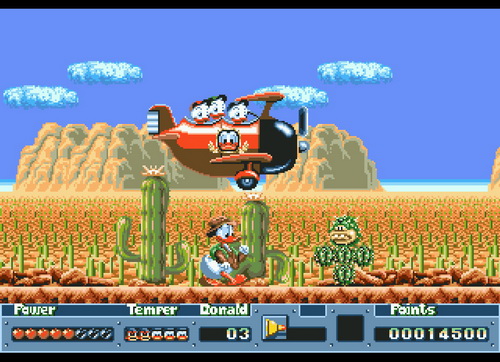
This game was all about the adventure, and that's what made it so memorable. You had to solve ancient riddles and deadly puzzles, such as when Donald would be trapped in a room with the ceiling collapsing, and you had to step on floor tiles in a certain order as depicted on a scrap of paper that he would find earlier in the level. This, and the globe-trotting nature of the game, really gave it a feeling of something epic that was missing from most Disney games at the time. This was a pretty challenging and even lengthy game, fixing the problems a lot of Disney titles had at the time, without resorting to all out cheapness and frustration like the inferior ones. Donald controlled great, and the levels were long, well designed and full of secrets. Part of the fun was obtaining new abilities, and unlocking secrets in levels you had previously played, which was required in order to see the end.

Controlling Donald was also just fun. He could not just jump, but he could also slide under narrow passages and ride on rails. His weapon of choice on his adventure was a gun which shot plungers. Yeah, I know it's weird, but it works here. Not only could Donald stun enemies with his gun, but he could shoot plungers at walls and surfaces, which would temporarily stick. He could then use the plungers as platforms, and climb up tall shafts, or reach areas that were too wide to jump across. He had other weapons also, such as a gun that shot popcorn, or even bubbles. Again, it sounds strange, but Donald would have to use these items to uncover secrets in the levels, or blast away walls that would lead to hidden parts of the level.
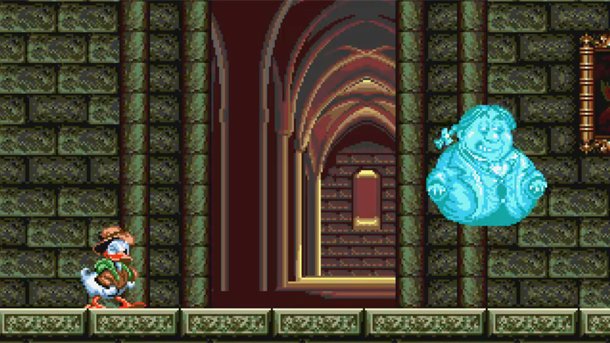
This was simply an ingenious game, combining the fun and imagination of the best Disney titles, with gameplay that was fine enough for kids, but could also challenge some older gamers. If you're into retro games, I highly recommend you give this one a chance. It's easily one of the best classic Disney games ever made.
Final Rating: 4 out of 4

DARKWING DUCK (1992)
FORMAT: NES
PUBLISHER: CAPCOM
Oh, was I pumped for this one to come out. Ever since it appeared on the Disney Afternoon in the fall of 1991, I immediately became a fan of the Darkwing cartoon. It's comedic action, satirical elements of popular comic book tropes at the time and weird villains had video game written all over it. So, I immediately started hoping for word that either Capcom or Sega had a game in the works. Sure enough, Capcom did not let me down, and I was elated. There was also a game by NEC for the Turbografx 16, but I've never played it, and based on what I've seen and heard about that game, I don't want to.

But let's talk about Darkwing Duck on the NES. It's obvious that the programmers decided to use Mega Man as their main inspiration as soon as you hit the Start button. The music, graphics and gameplay are pretty much identical to the Blue Bomber, except instead of fighting eight Robot Masters, you get to fight various villains from the show, including Bushroot, Megavolt, Quacker Jack and ultimately Steelbeak as the final boss. You can even play the levels in the order you choose, just like in Mega Man, although there's no strategy in picking the levels, since you don't get any special weapons when you beat the boss of a stage. The play control and level design also feel exactly like a Mega Man game, and the enemies even use similar attacks. That's not to say there's nothing new here. Darkwing does have a couple moves that Capcom's mascot did not, such as the ability to crouch, and use his cape as a shield in order to block bullets.
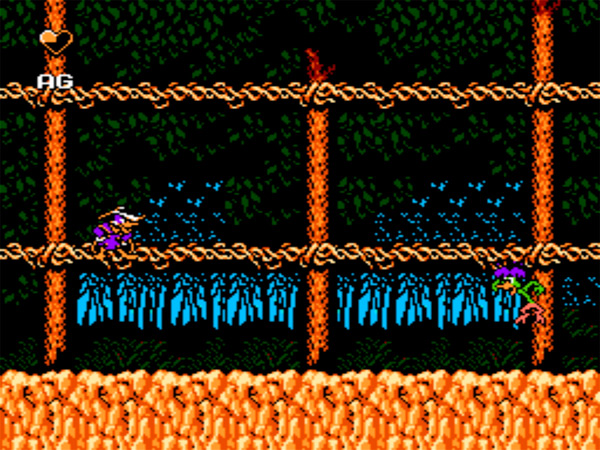
But is that really enough? I must stress, Darkwing Duck for the NES is a good game, and it provides a decent challenge. The only problem I have with it is that it feels so completely familiar. You're essentially playing a lost game in the Mega Man franchise, only with the "Terror That Flaps in the Night", instead of a robot. The thing that made Capcom's DuckTales and Rescue Rangers games stand out were their unique and fun attacks you could pull off, such as Scrooge's "pogo jump", or Chip and Dale picking up and throwing things, or even throwing each other. There is nothing unique here. You're just blasting enemies with a gun. The game also doesn't try to capture the humor of the cartoon, which could have gone a long way in making this game stand out from the pack. This is essentially a well designed, but incredibly basic game.

I think the best word that describes Darkwing Duck is "standard". It's very good for what it is, and I don't really complain when I'm playing the game. But, as a fan of the cartoon, I really think they could have done so much more with this. If you're looking for a 2D Mega Man adventure with a Disney theme, this will be right up your alley. It's a fun game, just a tiny bit disappointing when you know what Capcom is capable of.
Final Rating: 3 out of 4

WORLD OF ILLUSION: STARRING MICKEY MOUSE AND DONALD DUCK (1992)
FORMAT: SEGA GENESIS
PUBLISHER: SEGA
The third, and sadly, final Disney game to be made by Sega's talented "Illusion" Team of programmers. As the title suggests, World of Illusion basically ignores the adventure style of gameplay established in the previous Quackshot, and instead goes back to the more basic platforming featured in the original Castle of Illusion. Is this a disappointment? Maybe a little bit. But it doesn't hide the fact that this is yet another beautiful and imaginative game.

This time around, a two player mode has been added, allowing you to team up two of Disney's biggest stars, Mickey and Donald. As the game opens, they're practicing a magic act that they're about to perform for an audience later that night. While exploring backstage, Donald happens to find a strange door that leads to a magical other world. The two step through it, and find themselves trapped in the World of Illusion, which is run by the tyrannical wizard Pete. Mickey and Donald have magic of their own, which they can use to transform enemies into harmless creatures like butterflies. Their adventure will take them to a lot of strange places such as up in the clouds, swimming through a massive goldfish bowl, and inside a box of magic.

What made this game unique is that the game would change completely regarding who you were playing as, and if you were playing with a friend. For example, in the single player game, you could choose to play as Mickey or Donald. And while there was no real difference in how the characters played, the game itself would change in some way. There were secret levels and area that only a certain character could uncover, so the game would be different and have some unique levels depending on who you chose to play as. And in 2 player mode, the game would be even more different. There would be parts of levels not in the single player game, where the two characters would have to work together in order to pass. Not only that, but there were entirely new levels and areas to explore in 2 player mode. So, if you wanted to see the entirety of the game, you would have to play both the single player mode as both characters, AND play with a friend in 2 player mode.
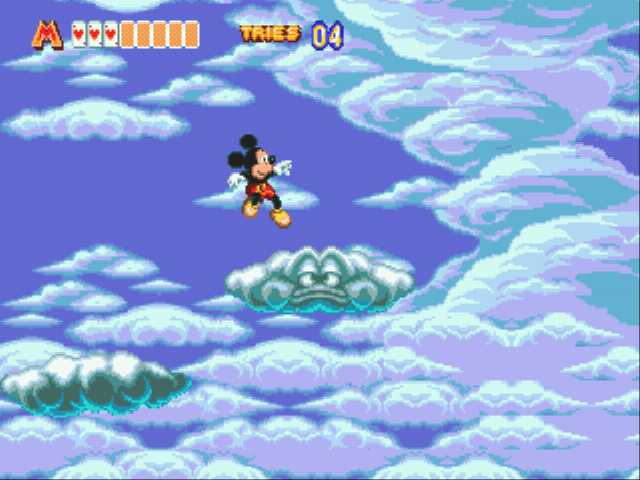
This is a great idea, and I kind of wish more games would have implemented it back in the day, as it really adds replay to a game to have it change in several ways depending on who you're playing as and how you play. And just like the previous two games, the graphics, animation and sound in this game were top notch when it came to the Genesis. They even through some digitized speech in the game for both Mickey and Donald, and it sounds pretty good. The character sprites are not as big as they were in Quackshot, but they're just as detailed and they animate just as smoothly. And while it doesn't quite reach the heights of Donald's starring adventure, this more than lives up to and builds upon the success of the charming Castle of Illusion.

This is another Disney game that has flown under the radar from most gamers, and that's really too bad, as there's a lot of warmth and fun behind this game. It really is a shame that this talented team of programmers didn't get to continue with the Disney license, as I think they only cracked the surface of what they could have done with their three games that they did for Sega. Still, it's a very good game, and that's all that counts.
Final Rating: 3.5 out of 4

THE MAGICAL QUEST: STARRING MICKEY MOUSE (1992)
FORMAT: SNES
PUBLISHER: CAPCOM
When the Super Nintendo launched, one of the things I was excited about was seeing how Capcom would continue their Disney license withe 16-bit. It did not take long to wait, and rather than base their first game on the new Nintendo system off of one of Disney's TV shows at the time, they decided to take a page from Sega's playbook and create an original adventure starring Disney's main mascot.

You can tell that Capcom was influenced by the "Illusion" series, as it has a very similar plot. Mickey, Donald and Goofy are in the park playing fetch with Pluto, when once again, that big dummy Goofy winds up screwing things up. He throws the ball too hard, beaning Mickey on the head, and Pluto goes running off wildly after the stray ball. Concerned, Mickey gives chase after his faithful pup, and both wind up falling off the edge of a cliff and into a magical world run by the evil Emperor Pete. (Boy, that Pete guy is everywhere in these alternate worlds, isn't he?) Pluto gets captured, and now Mickey must explore this strange new world to get him back.

Also like the Illusion games, this is a fairly basic platformer. However, instead of just jumping on the heads of enemies, Mickey can also pick up boxes that are floating in mid-air, and toss them at any foe that crosses his path. But the game's main gimmick is that Mickey would find different costumes along his quest that would give him special abilities. Some of these costumes included a mountain climbing gear suit, complete with a grappling hook (which brings back memories of an earlier Capcom game, Bionic Commando), a firefighter's suit with a hose to douse flaming enemies and harmful fiery debris, and a wizard costume which would give Mickey magical powers. You could change costumes at any time with a push of a button, and the game's strategy would be knowing what costume to use at what point in a level, as there were certain parts where using a certain ability was crucial to survival.

The costume aspect is a lot of fun to use, and I really enjoy the graphics in this game. Capcom obviously took advantage of the added muscle of the Super Nintendo, and created a beautiful graphical style that almost resembles soft water colors. Even the music is pretty good, though nothing to write home about. At least it never offends. On the whole, this is a good game, with a couple problems that hold it back. The biggest problem is that the levels are actually kind of boring in their design. Even though the levels are fairly large, there's really only one path you need to take. Any alternate path is ultimately a dead end, which seems kind of pointless. Also, some of the bosses in the game take way too many hits to defeat. And they sometimes require pinpoint accuracy in order to beat them. There are moments where you'll swear you hit the enemy squarely, but Mickey winds up taking damage. These aspects are annoying, but the game itself does manage to remain fun throughout. It's just not as special of an outing as I was hoping for when it came to Capcom taking Disney to 16-bit.

Still, the game was successful enough to spawn two sequels, one of which came out over here (The Great Circus Mystery: Starring Mickey and Minnie), and one that remained in Japan (Magical Quest 3 starring Mickey and Donald), and would not come out in the US until it was ported to the Game Boy Advance in 2005. I have not played those games, but from what I've heard, they're very similar to this, both in pros and cons. So, if you're a fan of this game, check them out. I like this game enough, but not enough for it to join my favorites.
Final Rating: 3 out of 4
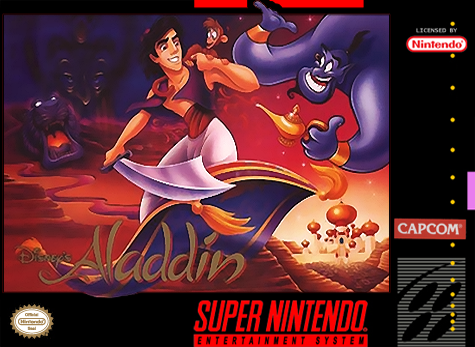
ALADDIN (1993)
FORMAT: SNES
PUBLISHER: CAPCOM
It's funny to think that given how huge Disney animated movies were in the early 90s that Capcom mostly stuck to their TV programs when it came to video games. In fact, aside from Aladdin, the only other Disney movie Capcom made a game of was The Little Mermaid for the NES (which I have not played). Regardless, given how huge Aladdin was with audiences, it's no surprise that Capcom took a chance with this one.

A couple years ago, I did an article here on Retro Junk about Great Games Based on Movies. In that article, I discussed at length the Aladdin game that Sega did for the Genesis at the time. I briefly mentioned Capcom's version for the SNES, which while not quite as impressive graphically, was still a very fun game. Both games follow the plot of the film pretty closely, but I think Capcom's version is just a little bit more faithful, with entire pieces of dialogue lifted from the film during the static "cinema" scenes. The character sprites in this game are kind of small, but they are gorgeously animated, with lots of cute touches. For example, when Aladdin battles the first boss in the game (an angry shopkeeper), you can see Abu the monkey in the background, encouraging Aladdin to fight, and throwing little punches.

The main thing that separated Capcom's take on Aladdin from the Sega version is that this game emphasized jumping and platforming, whereas the Genesis game was more of a hack and slash adventure. In this game, Aladdin could do cartwheels, bounce off of falling rocks, and even climb and push himself up over ledges, similar to the hero in the classic Prince of Persia games. There were some flying carpet levels to break up the standard but fun platforming as well, including a soothing bonus level based on the "Whole New World" scene, where you simply flew around on the carpet with Jasmine, picking up diamonds with no obstacles ahead of you. The soundtrack did feature some 16-bit synth versions of songs from the film, but a majority of it was original. And while the new music certainly wasn't bad, it just didn't stand out, much like in The Magical Quest.

But what mainly separates the two games is how they are designed. The Sega game was largely attempting to recreate the movie, with animation provided by real Disney animators, and touches of humor throughout ever level. Aladdin for the Super Nintendo is a much more traditional movie-based game, albeit a very good one, that takes you on a quick run through of famous scenes from the movie. The answer as to which game is better is subjective, and there's no real right answer. I enjoy both games greatly, though I do think the Genesis game is just slightly better, because it just stands out more.
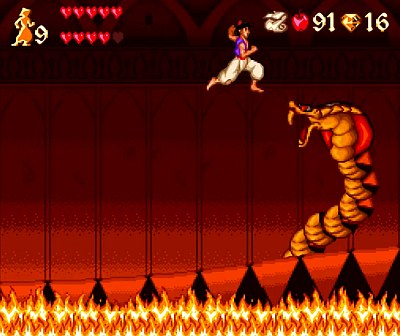
That certainly doesn't mean that this game slips up in any real way. It's actually quite fun, has a decent challenge, and is a more than worthy video game adaptation of the film. Like many of Capcom's later Disney games, it just feels a little bit standard, and maybe needed just a little extra something to really stand out.
Final Rating: 3 out of 4
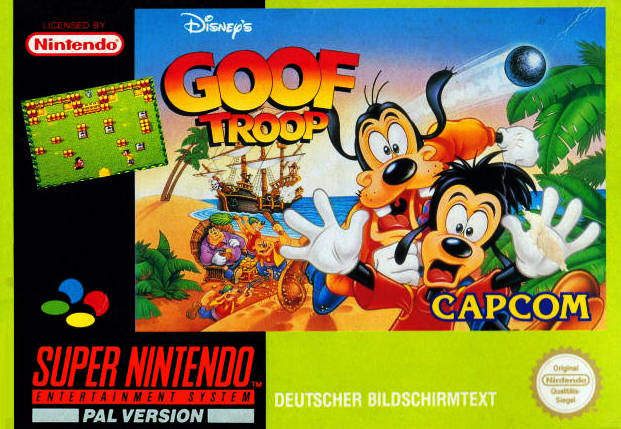
GOOF TROOP (1993)
FORMAT: SNES
PUBLISHER: CAPCOM
A video game based on the Goof Troop cartoon sounds like a strange idea. After all, the show was essentially an animated sitcom for kids featuring Goofy and Pete as feuding neighbors. How do you make a video game off of that idea? Turns out, if you're Capcom, you finally break from the mold and make something different than a standard platform game. In fact, you make it an incredibly fun two player puzzle adventure game that has a lot in common with The Legend of Zelda: A Link to the Past for the SNES. And no, I'm not kidding.

Let's get the plot out of the way. Goofy and his son Max are out fishing with their neighbors, Pete and P.J., when a pirate ship suddenly approaches and kidnaps Pete and his boy. Turns out the pirates have mistaken Goofy's neighbor for their lost Pirate Captain, who was recently swallowed by a whale. Goofy and Max must now explore a large tropical island that the pirates call home to rescue their friends, before the real Pirate Captain (who managed to escape from being the whale's lunch) returns, and makes Pete and P.J. walk the plank for impersonating him.
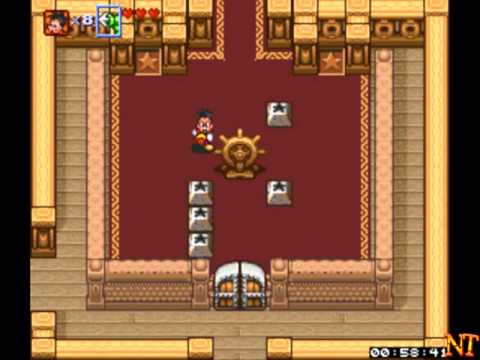
You could tackle the adventure alone (choosing to be either Goofy or Max), or with a friend in 2 player mode. And while single player mode was fun, this was a game that was meant to be played with a friend. This was a puzzle-based game, where you had to kick blocks and throw switches to sometimes make a path to the next screen, or sometimes to open doors or gates that were blocking your path. The puzzles naturally start out simple enough, but by the end of the game, could get pretty taxing, and it was usually a good idea to have a friend along to help you figure out the best way to solve whatever room you were in.

Goofy and Max even played differently. Goofy was slower, but also stronger, and could kill enemies, by picking up items like plants and rocks and throwing them, with fewer hits. Max was much faster than his dad, but physically weaker. A good part of the game emphasized teamwork, and required players to use the skills of the individual characters to their advantage. The best strategy was usually have Goofy take out the pirates roaming around the screen, while Max focused on solving the puzzles and triggering the booby traps safely so that both characters could cross. There was quite a bit of strategy behind the game, and you often had to stop and figure out the best way to advance, as almost every screen of the game's five levels has some kind of trick or method that you have to use in order to advance.
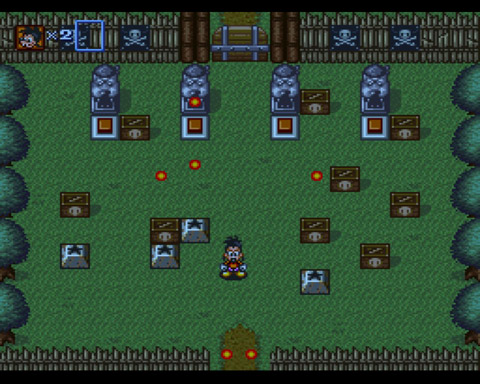
After so many of Capcom's past games had been basic platformers, Goof Troop came across as a breath of fresh air. Really, the only complaint that I have is that this is clearly a game designed for two players, and it's nowhere near as fun when you play alone. Still, no matter how you choose to play, you can really appreciate the effort the programmers put into this one, and how they didn't just make another cookie cutter game. Speaking of the programmers, one of the head people behind this game was Shinji Mikami, who would go on to create the Resident Evil franchise for Capcom on the Playstation just a couple years later. Going from a puzzle game with Goofy to a game where you blast zombies is quite a stretch. I guess after working on a family-friendly game, he wanted to do something darker and more violent.

But I digress. Goof Troop ends up being quite the fun and creative game, and definitely Capcom's best effort with a Disney license in quite a while.
Final Rating: 3.5 out of 4

THE LION KING (1994)
FORMAT: SNES/GENESIS
PUBLISHER: VIRGIN INTERACTIVE
If you were around in 1994, then you know how huge The Lion King was. It was the biggest Disney animated movie ever at the time, so naturally, a video game was not far behind. The honor went to Virgin Interactive, who the previous year had worked on Sega's Aladdin game. This time, they decided to release the game on both major platforms. I happened to have played the SNES version in my youth, so that's what this review will mainly be focused on. But, based on what I've seen of the Genesis version, there is not a huge difference between the two, aside from the obvious differences in graphics and sound.
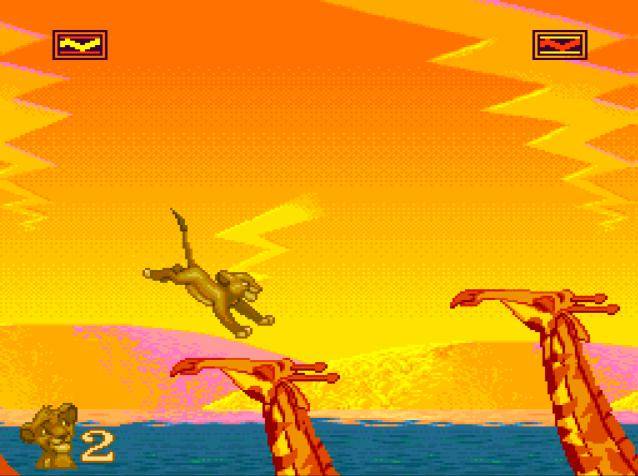
The game follows the plot of the movie quite closely, with you playing as Simba as a cub for the first few levels, and as an adult in the later levels. You get to play through various events such as the Elephant Graveyard, the stampede, Simba's exile from the Pridelands, and ultimately his return as he faces down his treacherous Uncle Scar. And both cub and adult Simba played differently and had their own attacks. Cub Simba could basically pounce, and stun enemies with his tiny roar. Adult Simba could swipe with his claws, lie on his back and throw enemies with his legs, and had a much stronger roar. This was a unique idea that hadn't really been done before in a platform game, but was necessary here to recreate the structure of the film. And while the control on Simba was not always spot on (there were some collision issues where you think you would hit an enemy, but it would not register sometimes), it still worked well for the most part.

And just like in Virgin's Aladdin game that they did for Sega, the graphics and animation were top of the line, as they were done by actual Disney artists. Not only did this allow the game to look and feel almost exactly like the movie (to the best that 16-bit technology would allow), but it gave the characters so much personality. When Simba is a cub, if you left him idle, a little butterfly would eventually start flying around him, and he would start pouncing and trying to catch it. The evil hyenas would pant and sometimes start scratching an itch. This doesn't sound like much, but it really made the game feel special when artists would throw in little touches like this. And while I can't vouch for the Genesis version, since I never played it, the music in the SNES game was superb, perfectly recreating most of the music from the film, including the African chorus chiming in at certain times. The game even featured quite a bit of digitized dialogue taken straight from the film to tell the story. When Mufassa tells Simba that everything the light touches is their kingdom after you beat the first level, that is actually James Earl Jones' voice speaking in the game, and it was a really good quality sound sample.

So, the presentation was the finest that 16-bit could offer. How is the gameplay? Well, the game is fun, but honestly I have to say the difficulty is tuned up way too high in certain parts of the game. There are moments here that seem deliberately designed for you to throw your controller against the wall in frustration, especially a stage late in the game where Simba has to travel through a series of caves, which warp him about the level, and send him to different areas. Unless you have an FAQ handy or draw yourself a map old school-style, good luck finding your way around. Going back to play it, I was reminded what a punishing game this could be sometimes. I was eventually able to beat it, but only after much trying.

Overall, this is a fun if not occasionally brutal game. With a little more tweaking of the difficulty before launch, this could have been one of the great ones. Still, the game is ambitious, and does a great job of recreating the movie. If you have the patience, this one will reward you.
Final Score: 3 out of 4

MICKEY MANIA: THE TIMELESS ADVENTURES OF MICKEY MOUSE (1994)
FORMAT: SNES/SEGA GENESIS/SEGA CD
PUBLISHER: SONY IMAGESOFT
This will be the last game on our retro Disney game journey, as it's the last one I played in my youth. This was a unique game, as unlike previous Mickey games, it did not have a story tying the levels together. Each level was based on a classic short cartoon, and the game in general served as a tribute to the famous Mouse's career.

The first level you would play was based on Steamboat Willie, and in a unique touch, the level itself would be in black and white, while your character sprite was in color. Other levels would trace Mickey's career from the past to the more recent present, and be based on cartoon shorts such as Lonesome Ghosts, Mickey and the Beanstalk, Moose Hunters, and ultimately 1990's The Prince and the Pauper (the most recent Mickey cartoon at the time the game was made). The object of each level was to find the hidden Mickey from each particular cartoon in every level. You could beat the game without finding all the Mickeys, but if you did, you would be treated to a hidden level based on the classic cartoon short, The Band Concert.

Just like all Disney games of the time, the artists really went out of their way to recreate the look of the classic cartoons, and gave the game a soft watercolor look. Each level had its own unique look, based on the art style of the time. The SNES and Genesis versions were very close in terms of quality of graphics and sound, which was kind of a nice change of pace. (Usually, the SNES had superior graphics and sound.) And then there was the Sega CD version, which was truly in a class by itself. Even though the game was exactly the same as the other versions, it had a few extra touches that made it stand out. With it being on CD, you not only got a more orchestral-sounding soundtrack, but you even got a commentary by Mickey himself. He would comment either on the action, or what was on his mind. So, when he would encounter a certain enemy or a spot in a level, he would have some kind of unique comment. There was quite a lot of voiced dialogue from Mickey throughout the game, which really added to the charm of the experience.

While this game isn't quite the classic that Castle of Illusion was (there are some hit detection issues here, just like in Lion King), the unique idea of playing through different classic cartoons and the overall charm of the graphics does make this a lot of fun, especially for animation history buffs. If I had to choose the best version, I would go for the Sega CD for the added sound. But, you really can't go wrong with any version here.
Final Rating: 3 out of 4

And at long last, we wrap up my personal history of Disney games while I was growing up. Again, I did not play all the Disney games that came out back then (Like the Tale Spin games.), so if you don't see one here, it's only because I don't have any personal memories of it. Also, I did not include the Kingdom Hearts games, because I was an adult when that series started off, and I'm focusing on my young past here.
I hope this article brought back some memories, and I hope you will add some of your own to the comment section if you have any. Thanks again, Retro Junkers, for allowing me to revisit my youth for a short while.

But let's talk about Darkwing Duck on the NES. It's obvious that the programmers decided to use Mega Man as their main inspiration as soon as you hit the Start button. The music, graphics and gameplay are pretty much identical to the Blue Bomber, except instead of fighting eight Robot Masters, you get to fight various villains from the show, including Bushroot, Megavolt, Quacker Jack and ultimately Steelbeak as the final boss. You can even play the levels in the order you choose, just like in Mega Man, although there's no strategy in picking the levels, since you don't get any special weapons when you beat the boss of a stage. The play control and level design also feel exactly like a Mega Man game, and the enemies even use similar attacks. That's not to say there's nothing new here. Darkwing does have a couple moves that Capcom's mascot did not, such as the ability to crouch, and use his cape as a shield in order to block bullets.

But is that really enough? I must stress, Darkwing Duck for the NES is a good game, and it provides a decent challenge. The only problem I have with it is that it feels so completely familiar. You're essentially playing a lost game in the Mega Man franchise, only with the "Terror That Flaps in the Night", instead of a robot. The thing that made Capcom's DuckTales and Rescue Rangers games stand out were their unique and fun attacks you could pull off, such as Scrooge's "pogo jump", or Chip and Dale picking up and throwing things, or even throwing each other. There is nothing unique here. You're just blasting enemies with a gun. The game also doesn't try to capture the humor of the cartoon, which could have gone a long way in making this game stand out from the pack. This is essentially a well designed, but incredibly basic game.

I think the best word that describes Darkwing Duck is "standard". It's very good for what it is, and I don't really complain when I'm playing the game. But, as a fan of the cartoon, I really think they could have done so much more with this. If you're looking for a 2D Mega Man adventure with a Disney theme, this will be right up your alley. It's a fun game, just a tiny bit disappointing when you know what Capcom is capable of.
Final Rating: 3 out of 4

WORLD OF ILLUSION: STARRING MICKEY MOUSE AND DONALD DUCK (1992)
FORMAT: SEGA GENESIS
PUBLISHER: SEGA
The third, and sadly, final Disney game to be made by Sega's talented "Illusion" Team of programmers. As the title suggests, World of Illusion basically ignores the adventure style of gameplay established in the previous Quackshot, and instead goes back to the more basic platforming featured in the original Castle of Illusion. Is this a disappointment? Maybe a little bit. But it doesn't hide the fact that this is yet another beautiful and imaginative game.

This time around, a two player mode has been added, allowing you to team up two of Disney's biggest stars, Mickey and Donald. As the game opens, they're practicing a magic act that they're about to perform for an audience later that night. While exploring backstage, Donald happens to find a strange door that leads to a magical other world. The two step through it, and find themselves trapped in the World of Illusion, which is run by the tyrannical wizard Pete. Mickey and Donald have magic of their own, which they can use to transform enemies into harmless creatures like butterflies. Their adventure will take them to a lot of strange places such as up in the clouds, swimming through a massive goldfish bowl, and inside a box of magic.

What made this game unique is that the game would change completely regarding who you were playing as, and if you were playing with a friend. For example, in the single player game, you could choose to play as Mickey or Donald. And while there was no real difference in how the characters played, the game itself would change in some way. There were secret levels and area that only a certain character could uncover, so the game would be different and have some unique levels depending on who you chose to play as. And in 2 player mode, the game would be even more different. There would be parts of levels not in the single player game, where the two characters would have to work together in order to pass. Not only that, but there were entirely new levels and areas to explore in 2 player mode. So, if you wanted to see the entirety of the game, you would have to play both the single player mode as both characters, AND play with a friend in 2 player mode.

This is a great idea, and I kind of wish more games would have implemented it back in the day, as it really adds replay to a game to have it change in several ways depending on who you're playing as and how you play. And just like the previous two games, the graphics, animation and sound in this game were top notch when it came to the Genesis. They even through some digitized speech in the game for both Mickey and Donald, and it sounds pretty good. The character sprites are not as big as they were in Quackshot, but they're just as detailed and they animate just as smoothly. And while it doesn't quite reach the heights of Donald's starring adventure, this more than lives up to and builds upon the success of the charming Castle of Illusion.

This is another Disney game that has flown under the radar from most gamers, and that's really too bad, as there's a lot of warmth and fun behind this game. It really is a shame that this talented team of programmers didn't get to continue with the Disney license, as I think they only cracked the surface of what they could have done with their three games that they did for Sega. Still, it's a very good game, and that's all that counts.
Final Rating: 3.5 out of 4

THE MAGICAL QUEST: STARRING MICKEY MOUSE (1992)
FORMAT: SNES
PUBLISHER: CAPCOM
When the Super Nintendo launched, one of the things I was excited about was seeing how Capcom would continue their Disney license withe 16-bit. It did not take long to wait, and rather than base their first game on the new Nintendo system off of one of Disney's TV shows at the time, they decided to take a page from Sega's playbook and create an original adventure starring Disney's main mascot.

You can tell that Capcom was influenced by the "Illusion" series, as it has a very similar plot. Mickey, Donald and Goofy are in the park playing fetch with Pluto, when once again, that big dummy Goofy winds up screwing things up. He throws the ball too hard, beaning Mickey on the head, and Pluto goes running off wildly after the stray ball. Concerned, Mickey gives chase after his faithful pup, and both wind up falling off the edge of a cliff and into a magical world run by the evil Emperor Pete. (Boy, that Pete guy is everywhere in these alternate worlds, isn't he?) Pluto gets captured, and now Mickey must explore this strange new world to get him back.

Also like the Illusion games, this is a fairly basic platformer. However, instead of just jumping on the heads of enemies, Mickey can also pick up boxes that are floating in mid-air, and toss them at any foe that crosses his path. But the game's main gimmick is that Mickey would find different costumes along his quest that would give him special abilities. Some of these costumes included a mountain climbing gear suit, complete with a grappling hook (which brings back memories of an earlier Capcom game, Bionic Commando), a firefighter's suit with a hose to douse flaming enemies and harmful fiery debris, and a wizard costume which would give Mickey magical powers. You could change costumes at any time with a push of a button, and the game's strategy would be knowing what costume to use at what point in a level, as there were certain parts where using a certain ability was crucial to survival.

The costume aspect is a lot of fun to use, and I really enjoy the graphics in this game. Capcom obviously took advantage of the added muscle of the Super Nintendo, and created a beautiful graphical style that almost resembles soft water colors. Even the music is pretty good, though nothing to write home about. At least it never offends. On the whole, this is a good game, with a couple problems that hold it back. The biggest problem is that the levels are actually kind of boring in their design. Even though the levels are fairly large, there's really only one path you need to take. Any alternate path is ultimately a dead end, which seems kind of pointless. Also, some of the bosses in the game take way too many hits to defeat. And they sometimes require pinpoint accuracy in order to beat them. There are moments where you'll swear you hit the enemy squarely, but Mickey winds up taking damage. These aspects are annoying, but the game itself does manage to remain fun throughout. It's just not as special of an outing as I was hoping for when it came to Capcom taking Disney to 16-bit.

Still, the game was successful enough to spawn two sequels, one of which came out over here (The Great Circus Mystery: Starring Mickey and Minnie), and one that remained in Japan (Magical Quest 3 starring Mickey and Donald), and would not come out in the US until it was ported to the Game Boy Advance in 2005. I have not played those games, but from what I've heard, they're very similar to this, both in pros and cons. So, if you're a fan of this game, check them out. I like this game enough, but not enough for it to join my favorites.
Final Rating: 3 out of 4

ALADDIN (1993)
FORMAT: SNES
PUBLISHER: CAPCOM
It's funny to think that given how huge Disney animated movies were in the early 90s that Capcom mostly stuck to their TV programs when it came to video games. In fact, aside from Aladdin, the only other Disney movie Capcom made a game of was The Little Mermaid for the NES (which I have not played). Regardless, given how huge Aladdin was with audiences, it's no surprise that Capcom took a chance with this one.

A couple years ago, I did an article here on Retro Junk about Great Games Based on Movies. In that article, I discussed at length the Aladdin game that Sega did for the Genesis at the time. I briefly mentioned Capcom's version for the SNES, which while not quite as impressive graphically, was still a very fun game. Both games follow the plot of the film pretty closely, but I think Capcom's version is just a little bit more faithful, with entire pieces of dialogue lifted from the film during the static "cinema" scenes. The character sprites in this game are kind of small, but they are gorgeously animated, with lots of cute touches. For example, when Aladdin battles the first boss in the game (an angry shopkeeper), you can see Abu the monkey in the background, encouraging Aladdin to fight, and throwing little punches.

The main thing that separated Capcom's take on Aladdin from the Sega version is that this game emphasized jumping and platforming, whereas the Genesis game was more of a hack and slash adventure. In this game, Aladdin could do cartwheels, bounce off of falling rocks, and even climb and push himself up over ledges, similar to the hero in the classic Prince of Persia games. There were some flying carpet levels to break up the standard but fun platforming as well, including a soothing bonus level based on the "Whole New World" scene, where you simply flew around on the carpet with Jasmine, picking up diamonds with no obstacles ahead of you. The soundtrack did feature some 16-bit synth versions of songs from the film, but a majority of it was original. And while the new music certainly wasn't bad, it just didn't stand out, much like in The Magical Quest.

But what mainly separates the two games is how they are designed. The Sega game was largely attempting to recreate the movie, with animation provided by real Disney animators, and touches of humor throughout ever level. Aladdin for the Super Nintendo is a much more traditional movie-based game, albeit a very good one, that takes you on a quick run through of famous scenes from the movie. The answer as to which game is better is subjective, and there's no real right answer. I enjoy both games greatly, though I do think the Genesis game is just slightly better, because it just stands out more.

That certainly doesn't mean that this game slips up in any real way. It's actually quite fun, has a decent challenge, and is a more than worthy video game adaptation of the film. Like many of Capcom's later Disney games, it just feels a little bit standard, and maybe needed just a little extra something to really stand out.
Final Rating: 3 out of 4

GOOF TROOP (1993)
FORMAT: SNES
PUBLISHER: CAPCOM
A video game based on the Goof Troop cartoon sounds like a strange idea. After all, the show was essentially an animated sitcom for kids featuring Goofy and Pete as feuding neighbors. How do you make a video game off of that idea? Turns out, if you're Capcom, you finally break from the mold and make something different than a standard platform game. In fact, you make it an incredibly fun two player puzzle adventure game that has a lot in common with The Legend of Zelda: A Link to the Past for the SNES. And no, I'm not kidding.

Let's get the plot out of the way. Goofy and his son Max are out fishing with their neighbors, Pete and P.J., when a pirate ship suddenly approaches and kidnaps Pete and his boy. Turns out the pirates have mistaken Goofy's neighbor for their lost Pirate Captain, who was recently swallowed by a whale. Goofy and Max must now explore a large tropical island that the pirates call home to rescue their friends, before the real Pirate Captain (who managed to escape from being the whale's lunch) returns, and makes Pete and P.J. walk the plank for impersonating him.

You could tackle the adventure alone (choosing to be either Goofy or Max), or with a friend in 2 player mode. And while single player mode was fun, this was a game that was meant to be played with a friend. This was a puzzle-based game, where you had to kick blocks and throw switches to sometimes make a path to the next screen, or sometimes to open doors or gates that were blocking your path. The puzzles naturally start out simple enough, but by the end of the game, could get pretty taxing, and it was usually a good idea to have a friend along to help you figure out the best way to solve whatever room you were in.

Goofy and Max even played differently. Goofy was slower, but also stronger, and could kill enemies, by picking up items like plants and rocks and throwing them, with fewer hits. Max was much faster than his dad, but physically weaker. A good part of the game emphasized teamwork, and required players to use the skills of the individual characters to their advantage. The best strategy was usually have Goofy take out the pirates roaming around the screen, while Max focused on solving the puzzles and triggering the booby traps safely so that both characters could cross. There was quite a bit of strategy behind the game, and you often had to stop and figure out the best way to advance, as almost every screen of the game's five levels has some kind of trick or method that you have to use in order to advance.

After so many of Capcom's past games had been basic platformers, Goof Troop came across as a breath of fresh air. Really, the only complaint that I have is that this is clearly a game designed for two players, and it's nowhere near as fun when you play alone. Still, no matter how you choose to play, you can really appreciate the effort the programmers put into this one, and how they didn't just make another cookie cutter game. Speaking of the programmers, one of the head people behind this game was Shinji Mikami, who would go on to create the Resident Evil franchise for Capcom on the Playstation just a couple years later. Going from a puzzle game with Goofy to a game where you blast zombies is quite a stretch. I guess after working on a family-friendly game, he wanted to do something darker and more violent.

But I digress. Goof Troop ends up being quite the fun and creative game, and definitely Capcom's best effort with a Disney license in quite a while.
Final Rating: 3.5 out of 4

THE LION KING (1994)
FORMAT: SNES/GENESIS
PUBLISHER: VIRGIN INTERACTIVE
If you were around in 1994, then you know how huge The Lion King was. It was the biggest Disney animated movie ever at the time, so naturally, a video game was not far behind. The honor went to Virgin Interactive, who the previous year had worked on Sega's Aladdin game. This time, they decided to release the game on both major platforms. I happened to have played the SNES version in my youth, so that's what this review will mainly be focused on. But, based on what I've seen of the Genesis version, there is not a huge difference between the two, aside from the obvious differences in graphics and sound.

The game follows the plot of the movie quite closely, with you playing as Simba as a cub for the first few levels, and as an adult in the later levels. You get to play through various events such as the Elephant Graveyard, the stampede, Simba's exile from the Pridelands, and ultimately his return as he faces down his treacherous Uncle Scar. And both cub and adult Simba played differently and had their own attacks. Cub Simba could basically pounce, and stun enemies with his tiny roar. Adult Simba could swipe with his claws, lie on his back and throw enemies with his legs, and had a much stronger roar. This was a unique idea that hadn't really been done before in a platform game, but was necessary here to recreate the structure of the film. And while the control on Simba was not always spot on (there were some collision issues where you think you would hit an enemy, but it would not register sometimes), it still worked well for the most part.

And just like in Virgin's Aladdin game that they did for Sega, the graphics and animation were top of the line, as they were done by actual Disney artists. Not only did this allow the game to look and feel almost exactly like the movie (to the best that 16-bit technology would allow), but it gave the characters so much personality. When Simba is a cub, if you left him idle, a little butterfly would eventually start flying around him, and he would start pouncing and trying to catch it. The evil hyenas would pant and sometimes start scratching an itch. This doesn't sound like much, but it really made the game feel special when artists would throw in little touches like this. And while I can't vouch for the Genesis version, since I never played it, the music in the SNES game was superb, perfectly recreating most of the music from the film, including the African chorus chiming in at certain times. The game even featured quite a bit of digitized dialogue taken straight from the film to tell the story. When Mufassa tells Simba that everything the light touches is their kingdom after you beat the first level, that is actually James Earl Jones' voice speaking in the game, and it was a really good quality sound sample.

So, the presentation was the finest that 16-bit could offer. How is the gameplay? Well, the game is fun, but honestly I have to say the difficulty is tuned up way too high in certain parts of the game. There are moments here that seem deliberately designed for you to throw your controller against the wall in frustration, especially a stage late in the game where Simba has to travel through a series of caves, which warp him about the level, and send him to different areas. Unless you have an FAQ handy or draw yourself a map old school-style, good luck finding your way around. Going back to play it, I was reminded what a punishing game this could be sometimes. I was eventually able to beat it, but only after much trying.

Overall, this is a fun if not occasionally brutal game. With a little more tweaking of the difficulty before launch, this could have been one of the great ones. Still, the game is ambitious, and does a great job of recreating the movie. If you have the patience, this one will reward you.
Final Score: 3 out of 4

MICKEY MANIA: THE TIMELESS ADVENTURES OF MICKEY MOUSE (1994)
FORMAT: SNES/SEGA GENESIS/SEGA CD
PUBLISHER: SONY IMAGESOFT
This will be the last game on our retro Disney game journey, as it's the last one I played in my youth. This was a unique game, as unlike previous Mickey games, it did not have a story tying the levels together. Each level was based on a classic short cartoon, and the game in general served as a tribute to the famous Mouse's career.

The first level you would play was based on Steamboat Willie, and in a unique touch, the level itself would be in black and white, while your character sprite was in color. Other levels would trace Mickey's career from the past to the more recent present, and be based on cartoon shorts such as Lonesome Ghosts, Mickey and the Beanstalk, Moose Hunters, and ultimately 1990's The Prince and the Pauper (the most recent Mickey cartoon at the time the game was made). The object of each level was to find the hidden Mickey from each particular cartoon in every level. You could beat the game without finding all the Mickeys, but if you did, you would be treated to a hidden level based on the classic cartoon short, The Band Concert.

Just like all Disney games of the time, the artists really went out of their way to recreate the look of the classic cartoons, and gave the game a soft watercolor look. Each level had its own unique look, based on the art style of the time. The SNES and Genesis versions were very close in terms of quality of graphics and sound, which was kind of a nice change of pace. (Usually, the SNES had superior graphics and sound.) And then there was the Sega CD version, which was truly in a class by itself. Even though the game was exactly the same as the other versions, it had a few extra touches that made it stand out. With it being on CD, you not only got a more orchestral-sounding soundtrack, but you even got a commentary by Mickey himself. He would comment either on the action, or what was on his mind. So, when he would encounter a certain enemy or a spot in a level, he would have some kind of unique comment. There was quite a lot of voiced dialogue from Mickey throughout the game, which really added to the charm of the experience.

While this game isn't quite the classic that Castle of Illusion was (there are some hit detection issues here, just like in Lion King), the unique idea of playing through different classic cartoons and the overall charm of the graphics does make this a lot of fun, especially for animation history buffs. If I had to choose the best version, I would go for the Sega CD for the added sound. But, you really can't go wrong with any version here.
Final Rating: 3 out of 4

And at long last, we wrap up my personal history of Disney games while I was growing up. Again, I did not play all the Disney games that came out back then (Like the Tale Spin games.), so if you don't see one here, it's only because I don't have any personal memories of it. Also, I did not include the Kingdom Hearts games, because I was an adult when that series started off, and I'm focusing on my young past here.
I hope this article brought back some memories, and I hope you will add some of your own to the comment section if you have any. Thanks again, Retro Junkers, for allowing me to revisit my youth for a short while.
13
Login To Vote!
More Articles From Keiichi77













